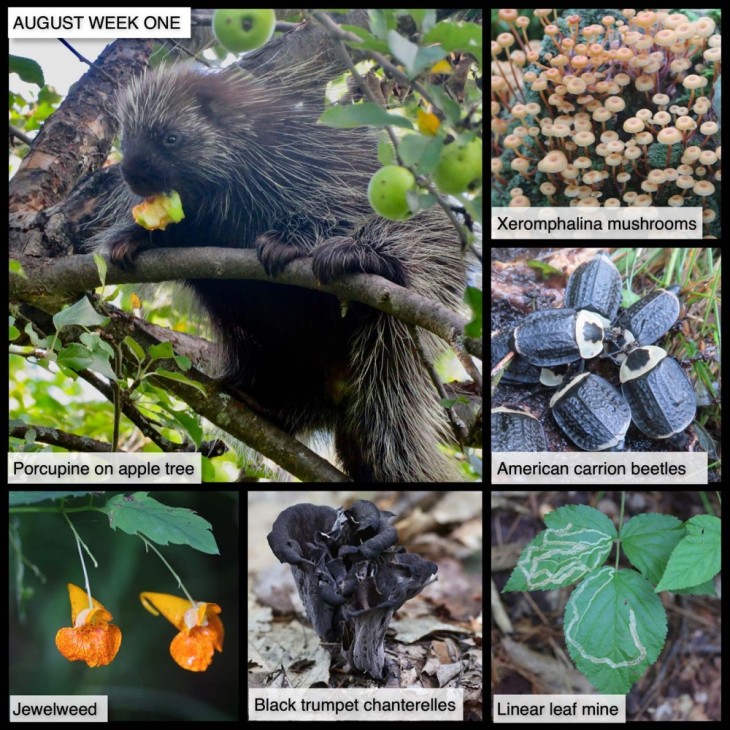This Week in the Woods, assistant editor Meghan McCarthy McPhaul found two porcupines perched in an apple tree, chowing down on the developing fruit. According to Uldis Roze, in his excellent book, The North American Porcupine, porcupines’ apple consumption peaks in July and August, and the animals strongly prefer less acidic varietals. (Red Delicious is a favorite.) As Roze notes, there’s a good reason for this preference: the more acidic a porcupine’s diet, the more difficulty the animal has retaining sodium, and therefore maintaining a healthy potassium-sodium ratio that’s critical for metabolic function. All of this has us thinking we should check out the pH of apple varietals when choosing trees to plant for wildlife.
Here are some other nature sights this week (clockwise):
For sheer fungal abundance, it’s hard to beat Xeromphalina. These small mushrooms – more than one species – grow in massive numbers on rotten wood, and we’ve been seeing them frequently the past few days in both hardwood and softwood stands. If you examine them closely, you’ll see indented caps and gills with intersecting veins. The mushrooms in the photo are probably X. kauffmanii. Here’s a profile of that species from Michael Kuo’s Mushroom Expert blog.
Speaking of teeming abundance, Meghan McCarthy McPhaul found these American carrion beetles crawling all over something unidentified and very dead (be grateful for our photo cropping skills!). Adult beetles fly, and they seek out decomposing meat by smell. They feed on a carcass and lay their eggs next to it in the soil. These hatch, and then the larvae feed…let’s just leave it there, shall we? While they’ll never have the popularity of butterflies, these and other species in the large family of Silphidae do important work as nature’s clean-up crew. Here’s a post about carrion beetles from the University of Wisconsin Milwaukee’s “Bug Lady.” And here’s an Outside Story by Rod Vallee about another type of Silphidae, the burying beetle.
Those squiggly white lines that you’re finding on leaves are the work of leaf mining insects, a large group that includes larvae of moths, sawflies, flies, and beetles. As noted in Charley Eiseman and Noah Charney’s book, Tracks & Sign of Insects and Other Invertebrates (a must-have for the insect obsessed), leaf mining is a form of “foliage feeding in which a larva lives between the two epidermal layers of a leaf, feeding on the tissue in between.” The book goes on to divide leaf mines by shape: linear mines, such as the one shown in this photo, and blotch mines, which may start out linear but broaden into a larger feeding area.
Black trumpet chanterelles have emerged and, apparently, are quite tasty. Timothy Baroni, in Mushrooms of the Northeastern United States and Eastern Canada, writes that they’re “highly prized for the flavor they produce when dried and then crumbled up for use as a condiment in scrambled eggs and other dishes.” We just like to look at them. They’ll appear in the woods between now and mid-autumn.
Finally, bright orange jewelweed is blooming now, and will continue to do so until first frost. This plant isn’t especially picky about its habitat, but we most often find it along wetlands and in other places with damp soil. One of the fun aspects of jewelweeds is that when their seed pods ripen, they burst open and eject their seeds (simply touching them can trigger this). Here’s a profile from the U.S. Forest Service, and here’s a fun article by Francette Cerulli from the Summer 2007 issue of Northern Woodlands magazine.
Our thanks to The Bailey Charitable Foundation and the Frank and Brinna Sands Foundation for helping to support this series.
In this difficult period, many of us find joy in observing local nature. This series, launched in April 2020, shares nature photographs taken in the past seven days, or in the same week in 2020, most within 15 miles of the Northern Woodlands office in Lyme, New Hampshire. We hope you enjoy using this grid as a prompt for your own explorations.
What are you seeing in the woods this week? Share your images with us on Facebook, or submit a special photo for possible inclusion in our monthly online Reader Photo Gallery.



Discussion *